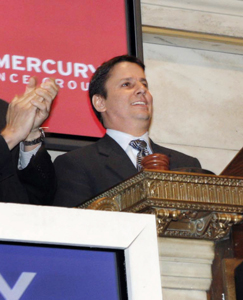Like other insurance companies, Mercury General Corp. was hit with claims from Hurricane Sandy. But its fourth-quarter earnings were worse than expected, and not just because of the East Coast storm.
The Los Angeles insurer was also hit hard by a recent trend toward more severe and costly auto accidents in its California auto insurance market. That forced the company to raise the amount it set aside to cover auto injury claims, money that comes out of the company’s earnings.
“As we evaluated our 2012 accident year results, we felt it was appropriate to increase our bodily injury severity takes (or reserves) for the entire 2012 accident year,” Chief Executive Gabriel Tirador told analysts in an earnings conference call last week.
These higher accident costs – along with the Hurricane Sandy claims and a one-time restructuring charge – contributed to the bigger-than-expected loss Mercury reported last week. The company reported a net loss of $17.4 million, or 32 cents a share, compared with net income of $79.5 million, or $1.45 a share, in the same period a year earlier. The consensus estimate had been for earnings of 23 cents a share.
Investors reacted by sending shares tumbling 5 percent to $37.74 for the week ending Feb. 6, making Mercury one of the biggest losers on the LABJ stock index. (See page 32.) The stock is down 13 percent from its year-ago price.
Costly auto claims
In his comments to analysts last week, Tirador said, “We believe the increase in (bodily injury) severity we are seeing is in part due to more severe accidents.”
He went on to say that medical bills and the frequency of certain medical procedures, such as epidural injections for pain control, also increased.
Tirador could not be reached for additional comment for this article last week.
Mercury is not alone in facing this trend toward higher payouts for auto accidents. According to Bloomberg analyst Jonathan Adams, Travelers Insurance Co. in Hartford, Conn., also reported more severe accidents and bodily injury losses. One analyst suggested that culprits may include the increased complexity of vehicles, which makes them more expensive to fix, and higher medical costs.
“It appears as though auto claim severity has been rising, probably due to more complex cars, higher repair costs and medical inflation,” said Meyer Shields, a property/casualty insurance analyst with Stifel Nicolaus & Co. Inc. in New York.
Tirador’s comments to analysts suggest that rising medical treatment costs are the primary culprit.
As for why this hit Mercury so hard in the fourth quarter, Tirador said that’s when the company traditionally receives the largest number of auto accident claims in California.
Mercury is particularly vulnerable when unexpected cost increases hit, according to Shields, because roughly three-fourths of its auto insurance business is in California, where regulators are resistant to approving insurers’ full rate hike requests.
“Mercury’s particular challenge is the California insurance regulator’s above-average hostility to rate increases,” Shield said. “This makes increasing rates in response to higher claim costs both slower and less likely than in most other states.”
Cost increases continuing?
Adding to Mercury’s fourth quarter troubles was Hurricane Sandy. Tirador said total hurricane-related losses for the quarter were $28 million: $22 million from homeowners and $6 million from auto owners.
Given that the storm struck the mid-Atlantic coast midway through the quarter, it’s likely that claims will continue to come in during the first quarter.
Meanwhile, the company last month began a cost-saving move of consolidating operations outside of California into hubs in Florida, New Jersey and Texas. The process is expected to be finished in the second quarter. Tirador said Mercury General expects $8 million to $13 million in pre-tax charges in the current quarter related to the restructuring.
Finally, a new California law goes into effect on March 30 that puts tighter restrictions on the use of aftermarket auto parts for vehicle repairs. The aim is to reduce the likelihood that defective parts are used. Aftermarket parts are generally cheaper than original parts, so repair costs are widely expected to increase.
Tirador said in his conference call that Mercury General mostly uses original parts. But because it does sometimes use aftermarket parts, costs will likely go up.
“This regulation has the potential to increase our costs,” he said, “so we’re going to monitor the results very closely.”

